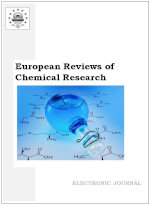4 December 15, 2016
Articles and Statements
1. Junjie Chen
Catalytic Ignition and Extinction of Hydrogen-Air Mixtures on Platinum Surfaces with Detailed Kinetics and Transport
European Reviews of Chemical Research, 2016, Vol.(10), Is. 4, pp. 102-111.
Number of views: 1846 Download in PDF
2. Natalia A. Forostyanaya, Anastasia D. Kutyavina, Larisa N. Maskaeva, Vyacheslav F. MarkovEuropean Reviews of Chemical Research, 2016, Vol.(10), Is. 4, pp. 102-111.
Abstract:
Surface ignition and extinction of very fuel-lean hydrogen-air mixtures on platinum surfaces were modeled using a detailed surface kinetic mechanism and transport phenomena. A stagnation-point flow geometry was employed to study the effect of heat flux, flow velocity, and composition on the surface ignition and extinction. The temperature and concentration on platinum surfaces as well as the coverage of surface species were also explored to evaluate the role of gas-phase chemistry. It was shown that the platinum surface can be poisoned by different adsorbates, and the dynamic process of surface ignition and extinction is associated with a phase transition from one poisoning species to another. For certain temperatures, multiple poisoned states of the surface coexist. Comparisons of simulations with experiments were carried out, and the results revealed that the self-inhibition of hydrogen surface ignition is caused by poisoning of platinum by atomic hydrogen.
Surface ignition and extinction of very fuel-lean hydrogen-air mixtures on platinum surfaces were modeled using a detailed surface kinetic mechanism and transport phenomena. A stagnation-point flow geometry was employed to study the effect of heat flux, flow velocity, and composition on the surface ignition and extinction. The temperature and concentration on platinum surfaces as well as the coverage of surface species were also explored to evaluate the role of gas-phase chemistry. It was shown that the platinum surface can be poisoned by different adsorbates, and the dynamic process of surface ignition and extinction is associated with a phase transition from one poisoning species to another. For certain temperatures, multiple poisoned states of the surface coexist. Comparisons of simulations with experiments were carried out, and the results revealed that the self-inhibition of hydrogen surface ignition is caused by poisoning of platinum by atomic hydrogen.
Number of views: 1846 Download in PDF
Kinetic Features of Cadmium Sulfide Deposition from Aqueous Solutions with Various Ligand Backgrounds
European Reviews of Chemical Research, 2016, Vol.(10), Is. 4, pp. 112-121.
Number of views: 1812 Download in PDF
3. Tatiana V. Vinogradova, Irina A. Glukhova, Larisa N. Maskaeva, Vyatcheslav F. MarkovEuropean Reviews of Chemical Research, 2016, Vol.(10), Is. 4, pp. 112-121.
Abstract:
A comparative kinetic study was carried out and formal kinetic equations were derived for the chemical deposition of cadmium sulfide from aqueous solutions containing various cadmium complexes onto a glass-ceramic substrate by thiourea under conditions of spontaneous nucleation and interfacial area control. The morphology of the resultant films were examined, on this basis their nanostructure nature was confirmed, taking into account the data on crystallite size analysis.
A comparative kinetic study was carried out and formal kinetic equations were derived for the chemical deposition of cadmium sulfide from aqueous solutions containing various cadmium complexes onto a glass-ceramic substrate by thiourea under conditions of spontaneous nucleation and interfacial area control. The morphology of the resultant films were examined, on this basis their nanostructure nature was confirmed, taking into account the data on crystallite size analysis.
Number of views: 1812 Download in PDF
Kinetic Aspects of Hydrochemical Deposition of Solid Phase Ag2S
European Reviews of Chemical Research, 2016, Vol.(10), Is. 4, pp. 122-129.
Number of views: 1835 Download in PDF
4. European Reviews of Chemical Research, 2016, Vol.(10), Is. 4, pp. 122-129.
Abstract:
The article considers kinetic aspects study of hydrochemical deposition of solid phase Ag2S from solutions containing silver nitrate, ammonium hydroxide and sodium citrate at temperatures 303-343 K in the conditions of the spontaneous formation of solid phase. The authors conclude that: 1. Particular kinetic orders are defined on all components of reaction mixture and activation energy of this process is 37 kJ/mole. 2. In the certain concentration limits formal kinetic equation was derived for the rate of conversion of silver salt into silver sulfide that allows to provide the regulation of the rate of silver sulfide phase formation in the investigated reaction mixture purposefully.
The article considers kinetic aspects study of hydrochemical deposition of solid phase Ag2S from solutions containing silver nitrate, ammonium hydroxide and sodium citrate at temperatures 303-343 K in the conditions of the spontaneous formation of solid phase. The authors conclude that: 1. Particular kinetic orders are defined on all components of reaction mixture and activation energy of this process is 37 kJ/mole. 2. In the certain concentration limits formal kinetic equation was derived for the rate of conversion of silver salt into silver sulfide that allows to provide the regulation of the rate of silver sulfide phase formation in the investigated reaction mixture purposefully.
Number of views: 1835 Download in PDF








